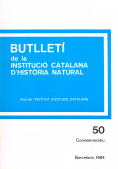Trets més destacats de l'obra pedològica d'Emili Huguet del Villar
Article Sidebar

Main Article Content
Jaume Bech i Borràs
Emili Huguet del Villar (1871-1951) was born in Granollers (Catalonia, Spain) and died in Rabat (Morocco). Geographer, geobotanist and soil scientist, he began working in Soil Science in 1923. In 1924 he presented a communication at the Conference of Rome and was one of the pioneers of Soil Science in the Western Mediterranean. He was the first person to inform on soils of Spain, Portugal, Morocco and Algeria. He was chairman of the Mediterranean Subcomission of Soil Science from 1929 until his death. His more representative works are: El suelo (1936), Los suelos de la Peninsula Luso-Iberica, The
tirs of Morocco (1944), Methode de Classification et Analyse des Sols (1953) and Geoedafologia
(1983, ed. by Marti).
Huguet del Villar had a dynamic vision of the soils, he spoke about «soils metabolisia», and had an interesting theory on hydrohipogenesis applied to tirsification, salinization and calcification.
In 1929 he proposed the first objective soil classification of universal application, based on intrinsic characters, which was also the first one presented under the form of a
taxonomic key.
He quoted paleosols and anticipated in calling K the calcium horizon. He organized the first Soil Institute in Spain (1932), the «Institut Mediterrani de Sòs», in Barcelona.
tirs of Morocco (1944), Methode de Classification et Analyse des Sols (1953) and Geoedafologia
(1983, ed. by Marti).
Huguet del Villar had a dynamic vision of the soils, he spoke about «soils metabolisia», and had an interesting theory on hydrohipogenesis applied to tirsification, salinization and calcification.
In 1929 he proposed the first objective soil classification of universal application, based on intrinsic characters, which was also the first one presented under the form of a
taxonomic key.
He quoted paleosols and anticipated in calling K the calcium horizon. He organized the first Soil Institute in Spain (1932), the «Institut Mediterrani de Sòs», in Barcelona.
Article Details
Com citar
Bech i Borràs, Jaume. “Trets més destacats de l’obra pedològica d’Emili Huguet del Villar”. Butlletí de la Institució Catalana d’Història Natural, pp. 47-60, https://raco.cat/index.php/ButlletiICHN/article/view/322267.
Articles més llegits del mateix autor/a
- Jaume Bech i Borràs, Contribució al coneixement dels sòls fersialítics del sud de Lió (França) , Butlletí de la Institució Catalana d'Història Natural: 1982: 48 : 1982 (Secció de Geologia, 3)
- Jaume Bech i Borràs, Sinopsi dels sòls dels Països Catalans , Butlletí de la Institució Catalana d'Història Natural: 1976: 40 : 1976 (Secció de Geologia, 1)
- Jaume Bech i Borràs, Victoriano Ramón Vallejo Calzada, Contribució al coneixement mineralògic d'uns sòls laterítics de l'Alt Volta , Butlletí de la Institució Catalana d'Història Natural: 1979: 43 : 1979 (Secció de Geologia, 2)